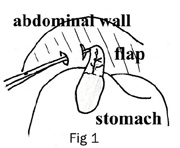
Belt-Loop Gastropexy
This technique is simple, rapid, and safe, and is my personal favorite on large breed dogs such as the Bloodhound. Belt loop gastropexy has a much lower recurrence rate of torsion than tube gastrotomy as well as a much stronger adhesion than either tube gastrotomy or incisional gastropexy. Since the stomach is not entered, there is not the risk of leakage of stomach contents or possible associated peritonitis. A 4 cm by 3 cm seromuscular flap is made in the pyloric antrum (stomach outlet), with a gastric vessel centered in the flap. Two small incisions, 3 cm apart, are made in the transverse muscle behind the last rib. The seromuscular flap of the stomach is passed through these incisions in the abdominal wall, and the flap is then re-sutured to the stomach (Fig 1 and 2). Stay sutures are also placed to hold the stomach to the abdominal wall. The flap incision in the stomach heals back to itself, and a strong adhesion forms between the stomach and the abdominal wall. The stay or tack sutures eventually break down, but the strength of the pexy is in the adhesions and the healed stomach flap. Anchoring the stomach to the right abdominal wall prevents the stomach from rotating on its axis.